【9】Quantum Cutting in Tm31Yb31-Codoped Lanthanum Aluminum
超导量子干涉器件(SQUID)实验
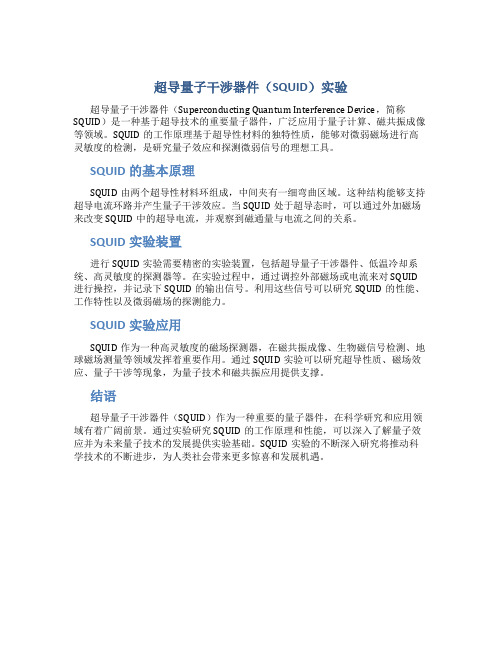
超导量子干涉器件(SQUID)实验
超导量子干涉器件(Superconducting Quantum Interference Device,简称SQUID)是一种基于超导技术的重要量子器件,广泛应用于量子计算、磁共振成像等领域。
SQUID的工作原理基于超导性材料的独特性质,能够对微弱磁场进行高灵敏度的检测,是研究量子效应和探测微弱信号的理想工具。
SQUID的基本原理
SQUID由两个超导性材料环组成,中间夹有一细弯曲区域。
这种结构能够支持超导电流环路并产生量子干涉效应。
当SQUID处于超导态时,可以通过外加磁场来改变SQUID中的超导电流,并观察到磁通量与电流之间的关系。
SQUID实验装置
进行SQUID实验需要精密的实验装置,包括超导量子干涉器件、低温冷却系统、高灵敏度的探测器等。
在实验过程中,通过调控外部磁场或电流来对SQUID 进行操控,并记录下SQUID的输出信号。
利用这些信号可以研究SQUID的性能、工作特性以及微弱磁场的探测能力。
SQUID实验应用
SQUID作为一种高灵敏度的磁场探测器,在磁共振成像、生物磁信号检测、地球磁场测量等领域发挥着重要作用。
通过SQUID实验可以研究超导性质、磁场效应、量子干涉等现象,为量子技术和磁共振应用提供支撑。
结语
超导量子干涉器件(SQUID)作为一种重要的量子器件,在科学研究和应用领域有着广阔前景。
通过实验研究SQUID的工作原理和性能,可以深入了解量子效应并为未来量子技术的发展提供实验基础。
SQUID实验的不断深入研究将推动科学技术的不断进步,为人类社会带来更多惊喜和发展机遇。
利用单光纤光镊实现不同折射率的微粒分选

第 31 卷第 8 期2023 年 4 月Vol.31 No.8Apr. 2023光学精密工程Optics and Precision Engineering利用单光纤光镊实现不同折射率的微粒分选钟慧1,高丙坤1,党雨婷1,赵忖2*,姜春雷1*(1.东北石油大学电气信息工程学院,黑龙江大庆 163318;2.东北石油大学秦皇岛校区电气信息工程系,河北秦皇岛 066004)摘要:为解决在进行不同折射率的微粒分类时遇到的问题,本文提出了一种采用熔融法拉伸的抛物线型光纤探针,所得到的出射光场对于浸没在水溶液中的不同折射率的微粒具有不同的操作能力,可以达到微粒分类的目的。
我们将波长为980 nm的激光通入光纤探针中,操控光纤在液体中实现对二氧化硅(SiO2)、聚苯乙烯(PS)和酵母菌细胞三种不同折射率的微粒及细胞的捕获和传输,进而实现不同微粒的分类。
基本上实现了对三种微粒在1~10 μm范围内的操控和分类。
通过仿真验证了这种抛物线型光纤探针对三种微粒具有不同捕获能力,所得到的理论和实验结果保持一致。
使用该方法对微粒进行分类,可以简化实验装置,并且在无标签混合光纤传感器的开发和传染病检测或细胞分类等方面有广泛应用。
关键词:光纤光镊;折射率;细胞筛选;微粒分类中图分类号:Q631 文献标识码:A doi:10.37188/OPE.20233108.1115Particle sorting with different refractive indices using singlefiber optical tweezersZHONG Hui1,GAO Bingkun1,DANG Yuting1,ZHAO Cun2*,JIANG Chunlei1*(1.College of Electrical Information Engineering, Northeastern Petroleum University,Daqing 163318, China;2.Department of Electrical Information Engineering, Northeast Petroleum University,Qinhuangdao Campus, Qinhuangdao 066004, China)* Corresponding author, E-mail: jiangchunlei_nepu@;48724332@ Abstract: In order to solve the problems encountered in classifying particles with different refractive indi⁃ces, this paper proposes a parabolic fiber optic probe stretched by the fusion method; the resulting outgo⁃ing light field has different operating capabilities for particles with different refractive indices submerged in aqueous solutions, which can be used for particle classification. We couple a laser beam with a wavelength of 980 nm into the fiber optic probe and manipulate the fiber to achieve the capture and transport of parti⁃cles and cells with three different refractive indices in liquid:silicon dioxide (SiO2),polystyrene (PS),and yeast cells, and thus achieve the classification of different particles in the range of 1-10 μm. The differ⁃ent capture capabilities of this parabolic fiber optic probe for the three particles were simulated, and the ob⁃tained theoretical and experimental results were in agreement. The use of this method to classify particles 文章编号1004-924X(2023)08-1115-09收稿日期:2022-07-01;修订日期:2022-09-27.基金项目:黑龙江自然科学基金资助项目(No.LH2021F008)第 31 卷光学精密工程simplifies the experimental setup and has a wide range of potential applications in the development of label-free hybrid fiber optic sensors, infectious disease detection, and cell classification.Key words: fiber optic tweezers; refractive index; cell screening; particle classification1 引言微粒、活细胞和大分子的无触点和无创分选是多学科研究的一个主要目标,特别是在生物医学和化学分析方面[1]。
量子剪裁效应
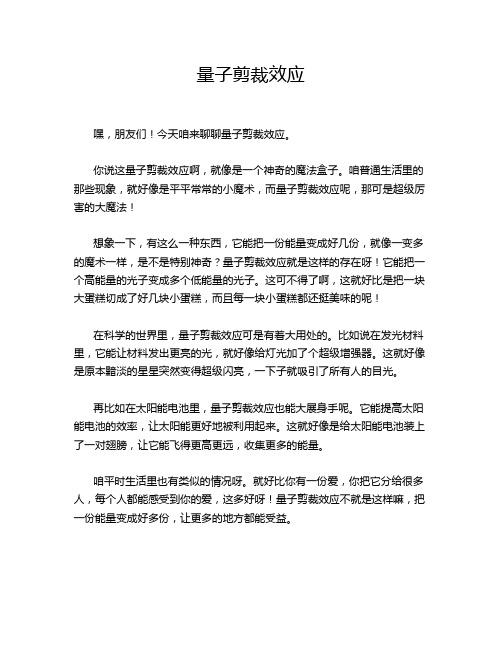
量子剪裁效应嘿,朋友们!今天咱来聊聊量子剪裁效应。
你说这量子剪裁效应啊,就像是一个神奇的魔法盒子。
咱普通生活里的那些现象,就好像是平平常常的小魔术,而量子剪裁效应呢,那可是超级厉害的大魔法!想象一下,有这么一种东西,它能把一份能量变成好几份,就像一变多的魔术一样,是不是特别神奇?量子剪裁效应就是这样的存在呀!它能把一个高能量的光子变成多个低能量的光子。
这可不得了啊,这就好比是把一块大蛋糕切成了好几块小蛋糕,而且每一块小蛋糕都还挺美味的呢!在科学的世界里,量子剪裁效应可是有着大用处的。
比如说在发光材料里,它能让材料发出更亮的光,就好像给灯光加了个超级增强器。
这就好像是原本黯淡的星星突然变得超级闪亮,一下子就吸引了所有人的目光。
再比如在太阳能电池里,量子剪裁效应也能大展身手呢。
它能提高太阳能电池的效率,让太阳能更好地被利用起来。
这就好像是给太阳能电池装上了一对翅膀,让它能飞得更高更远,收集更多的能量。
咱平时生活里也有类似的情况呀。
就好比你有一份爱,你把它分给很多人,每个人都能感受到你的爱,这多好呀!量子剪裁效应不就是这样嘛,把一份能量变成好多份,让更多的地方都能受益。
而且啊,这量子剪裁效应还在不断地被研究和探索呢。
科学家们就像一群好奇的探险家,在这个神奇的量子世界里不断地挖掘新的宝藏。
说不定哪天,就又会有新的发现和突破,那可真是让人期待啊!你说,这量子剪裁效应是不是特别有意思?它就像一个隐藏在科学世界里的小惊喜,等着我们去发现和探索。
咱可得好好关注它,说不定它以后能给我们的生活带来更大的改变呢!这可不是我瞎说,你想想看,科学的发展不就是这样嘛,总是会有一些意想不到的惊喜出现。
量子剪裁效应就是这样一个充满潜力的存在呀!。
量子剪裁ppt-科大施朝淑

初步观察到Gd2SiO5:Eu的量子剪裁现象 效率约180%,有待进一步研究
“Pr-Mn”离子对“量子剪裁”示意图
Sr0.99Pr0.01Al11.9Mg0.01O19 的发射谱 (激发波长185nm)
SrAl12O19:Pr按专利思想有量子 剪裁的发射谱
SrAl12O19:Pr按专利思想有量子 剪裁的发射谱
8
8000
5
0.05
S7/2 IJ
6
7000 6000
D 0
7
FJ
J=2
J=1
6
Intensity [a.u.]
0.04
8
Intensity [a.u.]
G d : S7/2 G J
0.03
8
3+ 8
6
S7/2 PJ
5000 4000
5
D 1
7
FJ
S7/2 DJ
6
X15
3000 2000
J= 0
1
2
能量下转换 (Downconversion) 吸收 一个高能光子(VUV)
上转换(Upconversion)
吸收 两个低能光子(IR)
发射 一个高能光子(VIS)
发射 两个低能光子(UV-VIS)
(白炽灯中的IR
VIS)
10 3cm -1
1
4
F 9/2
20
G4
2
15
F2
2
F3
2
F4
2
4
F 5/2
10
2) “RE3+-O2-”电荷迁移态靠近稀土离子的高激发态 形成被激发电子的“旁路”退激发
困难的解决办法
拟合成复合型氧化物或 “ 氟氧化物 ” 基质, 调谐基质的能隙为 ~7eV 左右,改变电荷 迁 移 态 ( CTS ) , 使 其 移 出 VUV 激 发 区,防止激发态电子“旁路”或泄漏。
聚焦离子束技术雕刻出的纳米级图案
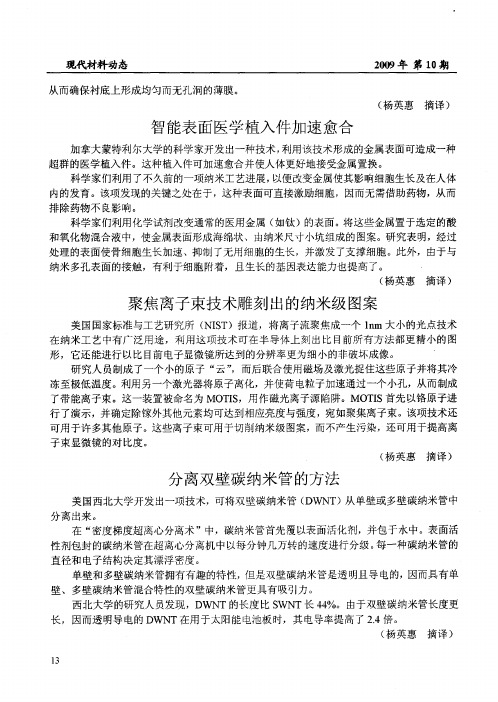
壁、多壁碳纳米管混合特性的双壁碳纳米管更具有吸引力。 西 北大 学 的研 究人 员发 现 ,D WNT的长 度 比 S T长 4%。由于 双壁碳 纳米 管长度 更 WN 4 长,因而透明导电的 D T在用 于太阳能电池板时,其电导率提高了 2 WN . 4倍。 ( 英惠 杨
内的发育 。该项发现的关键之处在于,这种表面可直接激励细胞,因而无需借助药物,从而 排 除药物 不 良影 响。 科学家 们 利用化 学试剂 改变 通常 的医 用金属 ( 如钛 )的表 面 。将 这些金 属 置于选 定 的酸 和氧 化物 混合 液 中,使金 属表 面形成 海 绵状 、由纳 米尺 寸小坑 组成 的图案 。研 究表 明,经 过 处理 的表 面使 骨细 胞生长 加速 、抑制 了无 用细 胞 的生长 ,并激 发 了支 撑细 胞 。此外 ,由于与
纳米 多孔表面 的接 触 ,有利 于细胞 附着 ,且 生长 的基因表 达 能力也提 高 了。 . ( 英惠 摘译 ) 杨
聚焦离子束技术雕刻 出的纳米级 图案
美国国家标准与工艺研究所 ( IT N S )报道,将离子流聚焦成一个 lm大小的光点技术 n 在 纳 米工 艺 中有 广泛 用途 ,利用 这 项技 术可 在 半 导体上 刻 出 比 目前所有 方 法 都更 精小 的 图 形 ,它还能进行 以比目前 电子显微镜所达到的分辨率更为细小的非破坏成像 。 研 究人 员制 成 了一个 小的原 子 “ ” 云 ,而后 联合 使用磁 场及激 光捉 住这 些 原子并 将其 冷 冻至极低温度。利用另一个激光器将原子离化,并使荷 电粒子加速通过一个小孔,从而制成 了带 能离 子束 。这一装 置 被命名 为 MO I,用作 磁光 离子源 陷 阱。MO I TS TS首先 以铬 原子进 行了演示,并确定除镓外其他元素均可达到相应亮度与强度,宛如聚集离子束。 该项技术还 可用 于许 多其 他原 子 。这些 离子 束可用 于切 削纳 米级 图案 ,而不产 生污 染 ,还 可用 于提 高离 子 束显微 镜 的对 比度 。 ( 英惠 摘译) 杨
量子剪裁发光材料

量子剪裁发光材料
我们设计了一种具有创新性和前瞻性的材料,可以用于量子剪裁发光技术。
这种材料基于近年来出现的新发现和研究成果,它能够调整光子的能量和波长,进而产生高效的发光效果。
该材料采用了一种特殊的结构和组成,能够有效地绑定光子并加以控制。
我们利用最先进的纳米技术和光学工程手段,精确地构造了材料的微观结构,以实现对光子的完美捕获和引导。
通过改变材料的组成比例和晶格结构,我们能够实现对光子能量的精确调控。
这一特性使得我们的材料能够应用于各种领域,例如显示技术、光纤通信、生物医学成像等。
尤其是在量子计算和量子通信领域,我们的发光材料有望发挥重要作用。
我们的研究团队在实验室中开展了一系列的实验证明,验证了该材料的优异性能。
通过精确调控材料的结构和组成,我们能够实现高效的发光效果,以及对光子的定向发射和控制。
我们相信这种量子剪裁发光材料将会在光电子领域引起广泛的关注和应用。
这项创新的研究成果有望推动光子学领域的发展,为未来的科技进步做出贡献。
在未来的研究中,我们将继续深入研究和优化这种材料,以实现更优异的性能和更广泛的应用场景。
中文版-Quantum量子科学仪器贸易北京有限公司

DRY ICE恒温器快速降温——大样品空间——光学引入——用户定制ICEoxford公司专门为用户提供多种性能优良的恒温器,为用户量身打造最为适合的恒温器是ICEoxford的一大特色。
ICEoxford可提供适用于各种应用的4K-800K干式恒温器。
ICEoxford干式恒温器凭借卓越的性能、超强的可靠性、经济的价格成为各个实验室的首选。
所有ICEOxford干式系统均为无液氦系统。
全干式系统可以在不用液氦的情况下提供低于4K的低温,为用户节省了大量的实验成本。
如此优良的性能、合理的价格、超长维护周期、超短降温时间使得ICEoxford全干式恒温器广泛应用于科学研究与工业生产。
尤其是受到追求良好性能、经济实惠、快速降温、可靠性的用户广泛赞誉。
在光谱学方面,该系统经常被用在穆斯堡尔谱、拉曼、紫外/可见、傅里叶红外、太赫兹、荧光、光致发光以及新兴的量子信息测量。
适用于多种测量的设计方案●超低震动:±30nm●高温可达800K●超快样品更换:低温→室温→低温全过程只要2小时●光学窗口:可满足穆思堡尔等多种光谱学测量●制冷功率:多种型号GM和脉冲管冷头可选●超超大样品空间:接受用户定制●电学引线:提供带引线样品托,用户也可自己设计引线●样品可以大角度范围旋转●提供完全的用户定制服务●快速交货DRY ICE 4K-VL真空连接进样恒温器ICEoxford4K真空连接进样恒温器,巧妙的设计方案使得恒温器的使用变得更加简便。
系统采用GM制冷机来冷却。
样品更换可以通过更换顶部小的真空罐和防辐射屏蔽罩来快速完成。
样品处于真空环境中,通过柔软的导热连接来获得冷头的冷量。
为了减小震动,系统采用波纹管和3d打印的减震框架将冷头和样品隔离。
性能温度范围4K-325K(可配500K组件)制冷功率@4.2K0.1-1.0 Watts温度稳定性±10mK样品环境真空样品空间直径60mm,高100mm样品震动±5μmDRY ICE8K-ULV超低震动恒温器DRY ICE8K-ULV系统是专门为光谱学测量而设计的超低振动系统。
高一科学探索英语阅读理解25题
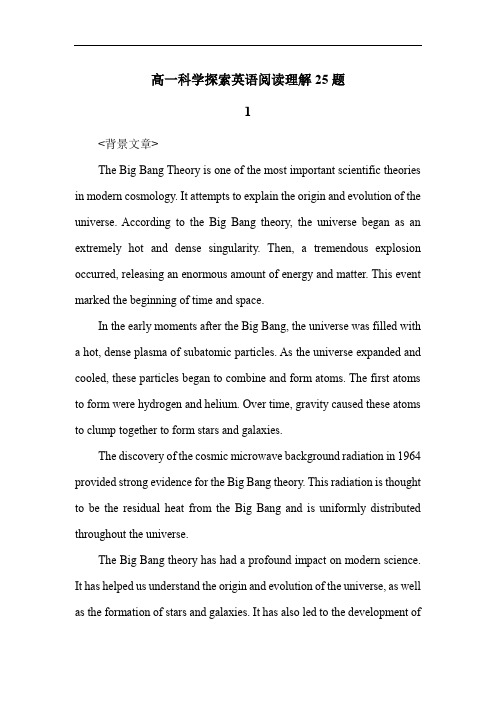
高一科学探索英语阅读理解25题1<背景文章>The Big Bang Theory is one of the most important scientific theories in modern cosmology. It attempts to explain the origin and evolution of the universe. According to the Big Bang theory, the universe began as an extremely hot and dense singularity. Then, a tremendous explosion occurred, releasing an enormous amount of energy and matter. This event marked the beginning of time and space.In the early moments after the Big Bang, the universe was filled with a hot, dense plasma of subatomic particles. As the universe expanded and cooled, these particles began to combine and form atoms. The first atoms to form were hydrogen and helium. Over time, gravity caused these atoms to clump together to form stars and galaxies.The discovery of the cosmic microwave background radiation in 1964 provided strong evidence for the Big Bang theory. This radiation is thought to be the residual heat from the Big Bang and is uniformly distributed throughout the universe.The Big Bang theory has had a profound impact on modern science. It has helped us understand the origin and evolution of the universe, as well as the formation of stars and galaxies. It has also led to the development ofnew technologies, such as telescopes and satellites, that have allowed us to study the universe in greater detail.1. According to the Big Bang theory, the universe began as ___.A. a cold and empty spaceB. an extremely hot and dense singularityC. a collection of stars and galaxiesD. a large cloud of gas and dust答案:B。
Tm^(3+)Ho^(3+)共掺含BaF_(2)纳米晶氟硅酸盐玻璃陶瓷2μm发光性能

第42卷第1期2021年1月发光学报CHINESE JOURNAL OF LUMINESCENCEVol.42No.1Jan.,2021文章编号:1000-7032(2021)01-0037-07Tm3+/Ho3+共掺含BaF2纳米晶氟硅酸盐玻璃陶瓷2pm发光性能傅燕青1,康世亮1*,关尚升1,郭跃琪S陈旦1,刘雪云1,徐铁峰心,林常规1*(1.宁波大学高等技术研究院红外材料及器件实验室,浙江宁波315211; 2.宁波海洋研究院,浙江宁波315211)摘要:由于在人眼安全、光电探测、中红外超连续谱产生等方面的应用,2.0帆波段中红外激光器引起了人们越来越广泛的关注。
本文采用熔融-淬冷法制备了含BaF2纳米晶、Tm3+离子单掺及Ho"/Tm"共掺的85SiO2-7.5KF-7.5BaF2(SKB)玻璃陶瓷,表征了样品的拉曼光谱、吸收光谱、808nm泵浦下在2.0^m处的发光性能,得到了实验过程中Ho"/Tm"的最佳掺杂浓度。
结果发现,Ho2O3、Tm2O3掺杂浓度均为1.0%时,2.0帆处Ho3+:1—工发射峰强度达到最大,并对Ho3+和Tm3+之间的能量转移机制进行了详细分析和讨论。
研究表明,Tm3+/Ho3+共掺的BaF2纳米晶SiO2-KF-BaF2玻璃陶瓷有望成为2.0^m波段中红外固体激光器的增益基质。
关键词:硅酸盐玻璃;稀土离子掺杂;2.0发光;BaF2;中红外发光中图分类号:O482.31文献标识码:A DOI:10.37188/CJL.20200310Luminescence Properties of Tm3+/Ho3+Doped BaF2Nanocrystalline Fluorosilicate Glass Ceramics at2.0pmFU Yan-qing1,KANG Shi-liang1*,GUAN Shang-sheng1,GUO Yue-qi1,CHEN Dan1,LIU Xue-yun1,XU Tie-feng1,2,LIN Chang-gui1*(boratory of Infrared Materials and Devices,Research Institute of Advanced Technologies,Ningbo University,Ningbo315211,China;2.Ningbo Institute of Oceanography,Ningbo315211,China)*Corresponding Authors,E-mail:ks!0118@;linchanggui@Abstract:2.0(xm band mid-infrared lasers have attracted more and more attention due to their applications in human eye safety,photoelectric detection,and generation of mid-infrared supercontinuum.In this paper,Tm3+ion doped and Ho3+/Tm3+co-doped85SiO2-7.5KF-7.5BaF2(SKB)glass containing BaF2nanocrystalline were prepared by melt-quenching method.The Raman spectrum, absorption spectrum and mid-infrared fluorescence performances of the samples at2.0(xm exited by 808nm laser diode were studied.The optimal doping concentration of Ho3+/Tm3+was obtained during the experiment.The measured fluorescence spectra manifest that the maximal emission intensity of Ho3+:订?一5I8at2.0(xm can be achieved at the concentration of1.0%H02O3and 1.0% Tm O3in this component glass.Besides,the energy transfer mechanisms between Ho3+and Tm3+ were also analyzed and discussed in detail.The results show that Tm3+/Ho3+co-doped SiO z-KF-BaF?收稿日期:2020-10-18;修订日期:2020-11-30基金项目:国家自然科学基金(61775110,51802299);国家重点研究开发计划(2016YFB0303802,2016YEB0303803);宁波大学王宽诚幸福基金资助项目Supported by National Natural Science Foundation of China(61775110,51802299);National Key Research and DevelopmentProgram of China(2016YFB0303802,2016YFB0303803);K. C.Wong Magna Fund in Ningbo LDiversity38发光学报第42卷glass ceramics can be used as the gain matrix for2.0Rm band mid-infrared solid-state laser.Key words:silicate glass;rare earth ion doped;2.0Rm fluorescence;BaF2;mid-infrared emission1引言工作在2.0Rm区域的固体激光器在遥感、大气污染监测、激光医学手术等领域的应用受到了越来越多的关注[1-3-°为了获得良好的稀土掺杂2.0Rm激光材料,首先需要选择合适的稀土离子。
星辰大海科普创新科学实验英语作文

全文分为作者个人简介和正文两个部分:作者个人简介:Hello everyone, I am an author dedicated to creating and sharing high-quality document templates. In this era of information overload, accurate and efficient communication has become especially important. I firmly believe that good communication can build bridges between people, playing an indispensable role in academia, career, and daily life. Therefore, I decided to invest my knowledge and skills into creating valuable documents to help people find inspiration and direction when needed.正文:星辰大海科普创新科学实验英语作文全文共3篇示例,供读者参考篇1The Cosmic Ocean of Innovation: Navigating the Frontiers of Astronomical DiscoveryAs a student captivated by the boundless expanse of the cosmos, I find myself in awe of the relentless pursuit ofknowledge that propels humanity to unveil the secrets of the universe. The vast celestial tapestry, woven with stars, galaxies, and enigmatic phenomena, beckons us to embark on an odyssey of exploration and innovation.In this age of unprecedented scientific progress, the field of astronomy stands as a beacon, illuminating the path towards uncharted territories. From the pioneering days of Galileo's revolutionary telescope to the awe-inspiring achievements of modern observatories and space probes, our understanding of the cosmos has undergone a transformative metamorphosis.One of the most remarkable milestones in recent years has been the advent of gravitational wave astronomy. These ripples in the fabric of spacetime, predicted by Einstein's theory of general relativity, have opened a new window into the most cataclysmic events in the universe. The groundbreaking detection of gravitational waves from a pair of merging black holes by the Laser Interferometer Gravitational-Wave Observatory (LIGO) in 2015 ushered in a new era ofmulti-messenger astronomy, where we can study cosmic phenomena through multiple channels – electromagnetic radiation, gravitational waves, and even neutrinos.This revolutionary discovery has profound implications for our comprehension of the cosmos. Gravitational waves offer an unprecedented glimpse into the most extreme environments in the universe, such as the collisions of black holes and neutron stars, processes that were once shrouded in mystery. By combining these observations with traditional electromagnetic observations, astronomers can paint a more comprehensive picture of the intricate dance of celestial objects, shedding light on the fundamental laws that govern the universe.Another frontier that has captivated the scientific community is the quest to unravel the enigma of dark matter and dark energy. These elusive components, which make up the vast majority of the universe's mass and energy, have long puzzled astronomers and physicists alike. Through cutting-edge observational techniques and sophisticated computational models, researchers are meticulously mapping the distribution of dark matter and studying its gravitational influence on the large-scale structure of the cosmos.The advent of powerful telescopes, both ground-based and space-based, has been instrumental in this endeavor. The James Webb Space Telescope, for instance, has revolutionized our ability to peer into the earliest epochs of the universe, unveilingthe birth and evolution of galaxies with unprecedented clarity. By studying the light from the most distant and ancient galaxies, astronomers can gain insights into the nature of dark matter and its role in shaping the cosmic tapestry.Beyond these groundbreaking discoveries, the field of astronomy continues to push the boundaries of innovation. Novel technologies, such as advanced adaptive optics and interferometry, are enabling astronomers to capture exquisitely detailed images of celestial objects, revealing intricate structures and dynamics that were once beyond our reach.Moreover, the burgeoning field of astroparticle physics, which combines the realms of astronomy and particle physics, is opening up new avenues for exploring the fundamental building blocks of the universe. By studying cosmic rays, neutrinos, and other high-energy particles from deep space, researchers are probing the most extreme environments in the cosmos, shedding light on phenomena that cannot be replicated in Earth-based laboratories.As a student witnessing this golden age of astronomical discovery, I am filled with a profound sense of wonder and excitement. The relentless spirit of innovation that drives thescientific community is truly awe-inspiring, propelling us towards realms once deemed unimaginable.Yet, amidst these groundbreaking advancements, I am reminded that the pursuit of knowledge is not merely a quest for personal gratification or academic accolades. It is a collective endeavor that transcends boundaries, uniting diverse cultures and nations in a shared mission to unravel the mysteries of the cosmos.Through international collaborations and the free exchange of ideas, astronomers from around the globe are forging new paths, fostering a global community dedicated to the advancement of human understanding. The collective effort to build and operate cutting-edge observatories and space missions is a testament to the power of cooperation and the boundless potential of humankind when we join forces in the pursuit of knowledge.As I gaze up at the night sky, contemplating the vast cosmic ocean that stretches before us, I am filled with a profound sense of humility and purpose. The universe, in all its grandeur and complexity, serves as a constant reminder of the infinite depths of knowledge yet to be explored, and the limitless potential for human ingenuity to unravel its secrets.In this era of unprecedented scientific progress, the field of astronomy stands as a beacon, illuminating the path towards uncharted territories. It is a journey that demands not only intellectual rigor and technological prowess but also a deep sense of wonder, curiosity, and an unwavering commitment to pushing the boundaries of human understanding.As a student, I am deeply inspired by the pioneering spirit of those who came before me, and I am emboldened by the knowledge that the quest for cosmic truths is an enduring legacy that transcends generations. With each new discovery, we inch closer to unveiling the grand tapestry of the universe, weaving together the threads of knowledge that will shape our understanding of the cosmos for generations to come.So let us embrace this odyssey of exploration and innovation, for it is in the pursuit of cosmic truths that we truly embody the essence of human potential – a relentless drive to transcend boundaries, to challenge convention, and to illuminate the vast expanse of the unknown. The cosmic ocean beckons, and we, as students and seekers of knowledge, are poised to navigate its uncharted depths, propelled by the unwavering spirit of scientific curiosity that has guided humanity since the dawn of time.篇2Exploring the Cosmos: An Innovative Science ExperimentAs a high school student, I've always been fascinated by the wonders of the universe. The twinkling stars, the swirling galaxies, and the vast expanse of space have captivated my imagination since childhood. However, it wasn't until my recent science project that I truly delved into the depths of cosmological exploration.Our science teacher, Ms. Johnson, challenged us to design and conduct an experiment that could contribute to our understanding of the cosmos. At first, the task seemed daunting. How could a group of high school students possibly make a meaningful impact on a field that has been studied by brilliant minds for centuries?Undeterred, my team and I brainstormed ideas, scouring through scientific journals and online resources. We were determined to think outside the box and come up with a unique approach. After weeks of research and countless discussions, we stumbled upon a groundbreaking concept – using radio waves to detect and analyze cosmic microwave background radiation.For those unfamiliar with the term, cosmic microwave background radiation (CMBR) is a relic from the early universe, a faint glow that permeates the entire cosmos. This radiation wasemitted approximately 380,000 years after the Big Bang, when the universe cooled enough for atoms to form and photons (light particles) to travel freely.Studying the CMBR has been a crucial endeavor for cosmologists, as it provides invaluable insights into the origin, evolution, and composition of the universe. However, most of the research in this field has been conducted using sophisticated and expensive equipment, often out of reach for high school students like ourselves.Our innovative approach was to build a simple yet effective radio telescope using readily available materials, such as a satellite dish, a low-noise amplifier, and a software-defined radio. By tuning our telescope to the specific frequency of the CMBR (around 1420 MHz), we aimed to detect and analyze this ancient radiation, potentially contributing to our understanding of the early universe.The construction process was not without its challenges. We had to carefully align the dish, calibrate the amplifier, and write custom software to interpret the data. There were countless setbacks and late nights spent troubleshooting issues. But our determination and teamwork kept us going, and eventually, wehad a fully functional radio telescope set up in the school's backyard.The moment of truth arrived when we pointed our telescope towards the constellation Virgo, known for its relatively low interference from other radio sources. As we analyzed the data, we were amazed to see a faint but unmistakable signal – the cosmic microwave background radiation itself!Excited by our initial success, we decided to take our experiment a step further. We used our telescope to map the variations in the CMBR across different regions of the sky. These variations, known as anisotropies, are incredibly small (on the order of one part in 100,000), but they hold invaluable information about the early universe's structure and the formation of the first galaxies.By comparing our data with existing models and simulations, we were able to identify potential correlations between the CMBR anisotropies and the distribution of matter in the universe. While our findings were preliminary and required further analysis, we couldn't help but feel a sense of pride and accomplishment.Throughout this project, we not only gained practical skills in electronics, programming, and data analysis but also developed a deeper appreciation for the scientific process. We learned theimportance of perseverance, collaboration, and critical thinking –skills that will undoubtedly benefit us in our future academic and professional endeavors.But perhaps the most significant lesson we learned was the power of curiosity and innovation. By daring to challenge conventional methods and thinking outside the box, we were able to make a small but meaningful contribution to the field of cosmology.As I look back on this experience, I can't help but feel inspired by the vast unknown that lies beyond our planet. The cosmos is a endless frontier, brimming with mysteries waiting to be unraveled. And who knows? Perhaps one day, our small experiment will serve as a stepping stone for future generations of scientists, pushing the boundaries of human knowledge even further.In the words of Carl Sagan, "Somewhere, something incredible is waiting to be known." With each innovative experiment, each daring hypothesis, and each groundbreaking discovery, we inch closer to unveiling the secrets of the universe. And that is a journey worth embarking on, no matter how small our contributions may seem.篇3Exploring the Cosmic Depths: A Student's Journey into Stellar ScienceAs a student with an insatiable curiosity about the wonders of the universe, I have always been captivated by the vast expanse of the cosmos. The twinkling stars that adorn the night sky have beckoned me to unravel the mysteries that lie beyond our terrestrial boundaries. It was this very fascination that led me to embark on an extraordinary journey – a journey that would not only ignite my passion for science but also push the boundaries of innovation.The Stellar Ocean Science Popularization Program, an initiative spearheaded by our school, opened a gateway to explore the depths of the celestial realm. Through a series of cutting-edge experiments and hands-on activities, we delved into the realms of astrophysics, cosmology, and astrobiology, unlocking the secrets that have puzzled humankind for centuries.One of the most memorable experiments was the construction of a scale model of our solar system. As we meticulously positioned each planet along a vast stretch of the school's field, the sheer vastness of the cosmic expanse becamestrikingly apparent. The distances between the planets, once mere numbers on a page, now took on a tangible form, leaving us in awe of the immense scales involved.But our exploration did not stop there. We ventured into the realm of spectroscopy, a technique that allowed us to analyze the composition of stars by studying the light they emit. Through a series of intricate setups involving diffraction gratings and spectrometers, we unraveled the secrets hidden within the very fabric of starlight. The vibrant lines and patterns that emerged on our screens held the key to understanding the elemental makeup of celestial bodies, a revelation that left us awestruck.Yet, the true magic unfolded when we delved into the realm of astrobiology – the study of life beyond Earth. We constructed miniature biospheres, simulating the conditions found on distant exoplanets, and observed how various microorganisms adapted and thrived in these alien environments. The prospect of life existing elsewhere in the universe was no longer a mere speculation but a tantalizing possibility that ignited our scientific curiosity.Moreover, our journey into the cosmos would not have been complete without exploring the cutting-edge field of astrophotography. Armed with advanced telescopes andstate-of-the-art imaging equipment, we captured breathtaking images of celestial wonders – from the swirling clouds of distant nebulae to the intricate details of planetary surfaces. Each photograph was a testament to the beauty and complexity of the universe, inspiring us to push the boundaries of our knowledge and understanding.Throughout this incredible journey, we were not mere passive observers but active participants in the process of scientific discovery. We formulated hypotheses, designed experiments, analyzed data, and drew conclusions, all while fostering a collaborative spirit of inquiry and critical thinking.One of the most rewarding aspects of this program was the opportunity to engage with renowned astrophysicists and researchers. Their guidance and expertise not only enriched our understanding but also opened our eyes to the vast array of career opportunities that awaited us in the field of space exploration and astronomical research.However, our journey was not without its challenges. We encountered obstacles, faced setbacks, and grappled with the complexities of the scientific process. Yet, it was through these very challenges that we learned the invaluable lessons ofperseverance, resilience, and the importance of embracing failure as a stepping stone towards growth and discovery.As I reflect on this incredible experience, I am filled with a profound sense of gratitude and awe. The Stellar Ocean Science Popularization Program has not only ignited my passion for the cosmos but has also instilled within me a deep appreciation for the power of science and innovation.The knowledge and skills I have acquired through this program have transcended the boundaries of textbooks and classrooms. They have empowered me with the ability to think critically, question assumptions, and approach challenges with a scientific mindset – invaluable assets that will undoubtedly shape my future endeavors, regardless of the path I choose to pursue.Moreover, this experience has reinforced my belief in the importance of science communication and popularization. By making complex scientific concepts accessible and engaging, we can inspire the next generation of explorers, thinkers, and innovators who will push the boundaries of human understanding and propel us towards unprecedented discoveries.As I look up at the night sky, the stars no longer merely twinkle; they beckon me to continue my journey of exploration,to unravel the secrets of the cosmos, and to contribute to the ever-expanding tapestry of human knowledge. With a renewed sense of wonder and determination, I embark on this lifelong quest, driven by the belief that the universe holds infinite possibilities waiting to be unveiled by the curious and the daring.。
原子级制造 量子效应 测量

原子级制造量子效应测量英文回答:Atomic-Scale Manufacturing: Quantum Effects and Measurement Requirements.Atomic-scale manufacturing involves manipulating and assembling individual atoms or molecules to create complex structures. This technology holds the promise of revolutionizing various fields, including electronics, medicine, and materials science. However, it presents unique challenges due to the influence of quantum effects at the atomic scale.Quantum Effects:At the atomic level, the behavior of particles is governed by quantum mechanics. This introducesprobabilistic and wave-like properties, which can significantly impact manufacturing processes. Two keyquantum effects are:Quantum Tunneling: Particles can overcome potential energy barriers even when their energy is below the barrier height. This phenomenon can lead to atoms "leaking" out of intended fabrication areas.Quantum Entanglement: The properties of multiple particles can become correlated, even if they arephysically separated. This makes it challenging to control and manipulate individual atoms precisely.Measurement Requirements:To effectively manipulate and assemble atoms at the nanoscale, precise measurement techniques are crucial. Conventional measurement approaches may not be sufficient due to:Heisenberg Uncertainty Principle: The act of measuring an atom's position or momentum affects its other properties. This limits the accuracy with which both properties can bemeasured simultaneously.Quantum Fluctuations: Quantum systems exhibit inherent fluctuations, making measurements noisy and potentially unreliable.Non-Invasive Measurement: Techniques are needed that do not disturb the delicate atomic structures being manipulated.Advanced Measurement Techniques:Various advanced measurement techniques have been developed to address these challenges:Scanning Probe Microscopy: Techniques like atomic force microscopy (AFM) and scanning tunneling microscopy (STM) allow precise imaging and manipulation of individual atoms.Quantum Interferometry: This technique utilizes the wave-like properties of atoms to measure their position andmomentum with improved precision.Cavity-Enhanced Spectroscopy: By confining atoms in a cavity, this technique enhances the interaction between atoms and light, enabling more sensitive spectroscopic measurements.Conclusion:Atomic-scale manufacturing requires a deep understanding and careful consideration of the quantum effects that govern the behavior of atoms. Precise measurement techniques are essential to overcome these challenges and enable the manipulation and assembly of atoms with atomic-scale precision. Ongoing advancements in measurement technologies will continue to push the boundaries of atomic-scale manufacturing, opening up new possibilities for innovation and discovery.中文回答:原子级制造,量子效应及其测量要求。
自然科学对话英语作文

自然科学对话英语作文标题,A Dialogue on Natural Science。
自然科学对话。
---。
Introduction。
Natural science plays a crucial role in understanding the world around us. Through observation, experimentation, and analysis, scientists uncover the mysteries of nature and contribute to the advancement of human knowledge. In this dialogue, two students, Alex and Sarah, engage in a conversation about various aspects of natural science, including biology, physics, and environmental science.---。
Alex: Hey, Sarah! Have you ever wondered how plantsconvert sunlight into energy?Sarah: Yeah, it's fascinating! They use a processcalled photosynthesis, where they absorb sunlight through chlorophyll and convert it into glucose and oxygen.Alex: Exactly! And did you know that photosynthesis not only produces food for plants but also generates the oxygen we breathe?Sarah: Wow, nature is truly amazing! Speaking of which, have you heard about the discovery of the Higgs boson particle in physics?Alex: Yeah, it's a groundbreaking achievement! The Higgs boson is often referred to as the "God particle" because it gives mass to other particles through the Higgs field.Sarah: I find quantum physics so intriguing. The idea that particles can exist in multiple states simultaneously challenges our understanding of reality.Alex: Definitely! Quantum mechanics opens up a whole new realm of possibilities and has practical applications in various fields, such as computing and cryptography.Sarah: Switching gears a bit, let's talk about environmental science. Climate change is a pressing issue facing our planet today.Alex: Absolutely. Human activities, such as burning fossil fuels and deforestation, release greenhouse gases into the atmosphere, leading to global warming and unpredictable weather patterns.Sarah: It's alarming to see the impact of climate change on ecosystems and biodiversity. We need to take action to reduce our carbon footprint and protect the environment for future generations.Alex: Agreed. Sustainable practices, renewable energy sources, and conservation efforts are essential steps toward mitigating the effects of climate change andpreserving Earth's natural resources.Sarah: I'm glad to see more people becoming aware of these issues and advocating for positive change. Education and awareness are key to addressing environmental challenges.Alex: Absolutely. By working together and implementing effective solutions, we can create a healthier and more sustainable planet for all living beings.---。
不断创新的USTER■ QUANTUM 3清纱器
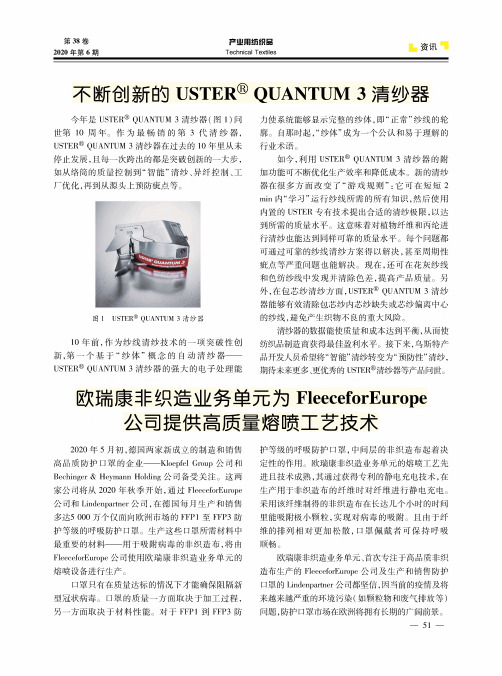
第38卷2020年第6期产"用纺%&Technical Textiles资讯不断创新的ESTER®QUANTUM3清纱器今年是USTER®QUANTUM3清纱器(图1)问世第10年。
作为最畅销的第3代,USTER®QUANTUM3清纱器在过去的10年里从未停止发展,且每一次跨岀的都是突破创新的一大步,从络筒的质量控“”、异纤控制、工厂优化,再到从源预防疵点等。
图1USTER®QUANTUM3清纱器10年前,作为的一项突破性创新,基于“”念的自动——USTER®QUANTUM3清纱器的强大的电子处理能力使系统能够显示完整的纱体,即“正常”纱线的轮)自那时起,“”为公认和易于的行业术语。
如今,利用USTER®QUANTUM3清纱器的附加功化生产效率和降低。
新的方面“游戏则”:它2 min内“学习”运行的识,然使用的USTER专适的极限,以达的质量水平。
这意味着物纤维和丙纶进行 达到同靠的质量水平。
问都通靠的方案得以解决,期疵点等严重问决。
,花和色纺中色差,提高产品质量。
另外,在包芯纱清纱方面,USTER®QUANTUM3清纱够失或芯纱偏离中心的,避免产生织物不良的重大风险。
的数据能使质量和达衡,从使纺织品制造商获得最佳盈利水平。
接下来,乌斯特产品希望将“”转为“预”,期待、的USTER®等产品问世。
非织造单元为FleeceforEurope 公司提供高质量熔喷工艺技术2020年5月初,德国两家新成立的制造和销售高品质防护口罩的企业---Kloepfel Group公司和Bechinger&Heymann Holding公司备受关注)这两家公司将从2020年秋季开始,通过FleeceforOurope 公司和Lindenpartneo公司,在德国每月生产和销售多达5000万个仅面向欧洲市场的FFP1至FFP3防护等级的呼吸防护口罩。
显微剪加工制作方法
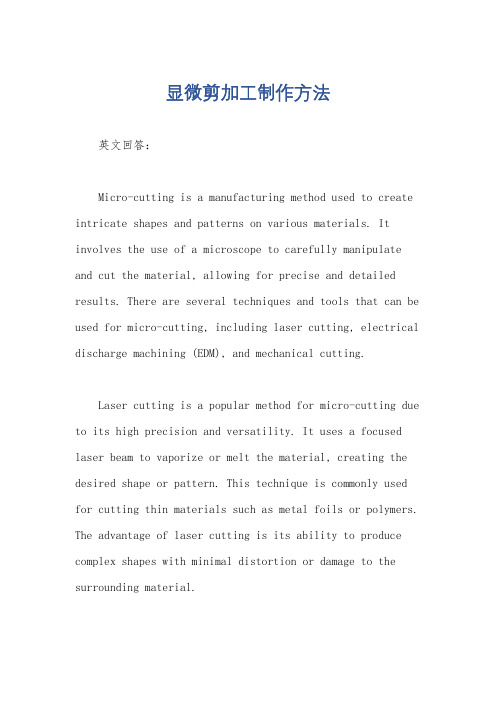
显微剪加工制作方法英文回答:Micro-cutting is a manufacturing method used to create intricate shapes and patterns on various materials. It involves the use of a microscope to carefully manipulate and cut the material, allowing for precise and detailed results. There are several techniques and tools that can be used for micro-cutting, including laser cutting, electrical discharge machining (EDM), and mechanical cutting.Laser cutting is a popular method for micro-cutting due to its high precision and versatility. It uses a focused laser beam to vaporize or melt the material, creating the desired shape or pattern. This technique is commonly used for cutting thin materials such as metal foils or polymers. The advantage of laser cutting is its ability to produce complex shapes with minimal distortion or damage to the surrounding material.EDM, on the other hand, is a non-contact cutting method that uses electrical discharges to remove material from the workpiece. It is particularly useful for cutting hard and brittle materials such as ceramics or semiconductors. The EDM process involves the creation of a spark between an electrode and the workpiece, which erodes the material and creates the desired shape. This technique allows for high precision and can produce intricate patterns with sharp edges.Mechanical cutting methods, such as milling or drilling, can also be used for micro-cutting. These techniquesinvolve the use of sharp cutting tools to remove material from the workpiece. While not as precise as laser cuttingor EDM, mechanical cutting methods are often more cost-effective and can be used for a wider range of materials. They are commonly used for cutting metals or plastics in industries such as electronics or automotive manufacturing.In addition to the cutting techniques, the choice of cutting parameters and tooling is crucial for achieving the desired results in micro-cutting. Factors such as cuttingspeed, feed rate, and tool geometry can greatly affect the quality of the cut. For example, a higher cutting speed may result in a smoother surface finish, while a lower feed rate can reduce the risk of tool breakage. It is important to carefully optimize these parameters based on the material properties and desired outcome.Micro-cutting is widely used in various industries, including electronics, aerospace, and medical device manufacturing. It allows for the creation of intricate components and structures that cannot be achieved through conventional machining methods. For example, micro-cutting is used to fabricate microelectromechanical systems (MEMS), which are tiny devices with both mechanical and electrical components. These devices are used in applications such as sensors, actuators, and microfluidic systems.In conclusion, micro-cutting is a versatile and precise manufacturing method that allows for the creation of intricate shapes and patterns on various materials. Whether it is through laser cutting, EDM, or mechanical cutting, the choice of technique and cutting parameters is crucialfor achieving the desired results. This method has revolutionized industries such as electronics and medical device manufacturing, enabling the fabrication of complex microstructures that are essential for modern technology.中文回答:显微剪加工是一种用于制作各种材料上复杂形状和图案的制造方法。
打破科技领域性别刻板印象的英语作文
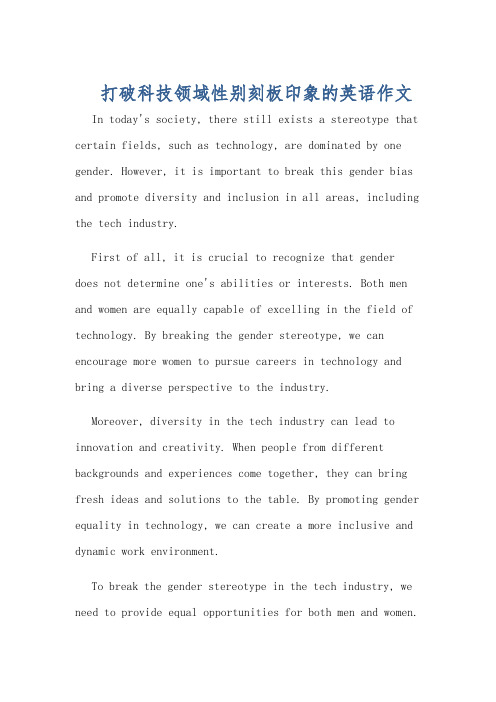
打破科技领域性别刻板印象的英语作文In today's society, there still exists a stereotype that certain fields, such as technology, are dominated by one gender. However, it is important to break this gender bias and promote diversity and inclusion in all areas, including the tech industry.First of all, it is crucial to recognize that gender does not determine one's abilities or interests. Both men and women are equally capable of excelling in the field of technology. By breaking the gender stereotype, we can encourage more women to pursue careers in technology and bring a diverse perspective to the industry.Moreover, diversity in the tech industry can lead to innovation and creativity. When people from different backgrounds and experiences come together, they can bring fresh ideas and solutions to the table. By promoting gender equality in technology, we can create a more inclusive and dynamic work environment.To break the gender stereotype in the tech industry, we need to provide equal opportunities for both men and women.This includes offering mentorship programs, scholarships, and networking opportunities to support women in technology. Companies can also implement diversity and inclusion initiatives to ensure a more balanced workforce.Overall, it is essential to challenge and break the gender bias in the tech industry. By promoting diversityand inclusion, we can create a more equal and innovative society.在当今社会,仍然存在一种刻板印象,即某些领域,比如科技,是由某一性别主导的。
海外科技掠影
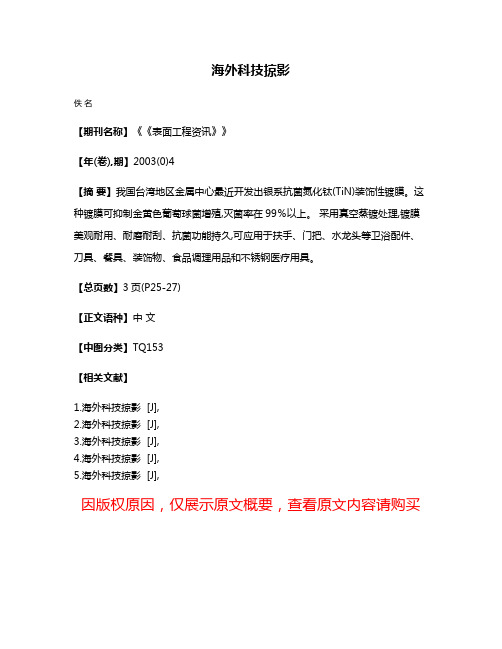
海外科技掠影
佚名
【期刊名称】《《表面工程资讯》》
【年(卷),期】2003(0)4
【摘要】我国台湾地区金属中心最近开发出银系抗菌氮化钛(TiN)装饰性镀膜。
这种镀膜可抑制金黄色葡萄球菌增殖,灭菌率在99%以上。
采用真空蒸镀处理,镀膜美观耐用、耐磨耐刮、抗菌功能持久,可应用于扶手、门把、水龙头等卫浴配件、刀具、餐具、装饰物、食品调理用品和不锈钢医疗用具。
【总页数】3页(P25-27)
【正文语种】中文
【中图分类】TQ153
【相关文献】
1.海外科技掠影 [J],
2.海外科技掠影 [J],
3.海外科技掠影 [J],
4.海外科技掠影 [J],
5.海外科技掠影 [J],
因版权原因,仅展示原文概要,查看原文内容请购买。
美国研究人员利用激光去除氢原子
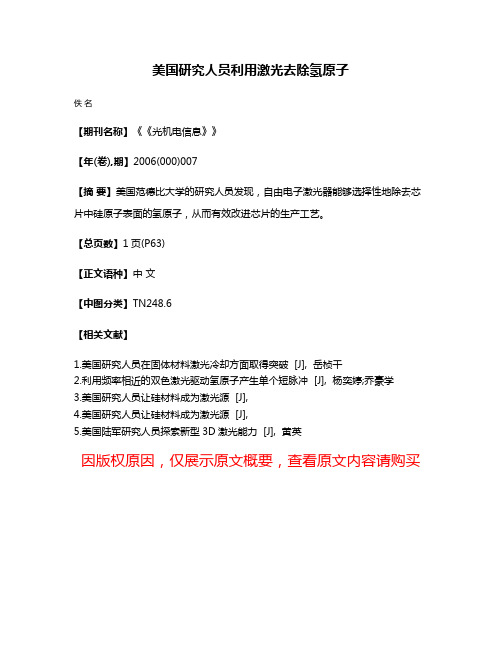
美国研究人员利用激光去除氢原子
佚名
【期刊名称】《《光机电信息》》
【年(卷),期】2006(000)007
【摘要】美国范德比大学的研究人员发现,自由电子激光器能够选择性地除去芯片中硅原子表面的氢原子,从而有效改进芯片的生产工艺。
【总页数】1页(P63)
【正文语种】中文
【中图分类】TN248.6
【相关文献】
1.美国研究人员在固体材料激光冷却方面取得突破 [J], 岳桢干
2.利用频率相近的双色激光驱动氢原子产生单个短脉冲 [J], 杨奕婷;乔豪学
3.美国研究人员让硅材料成为激光源 [J],
4.美国研究人员让硅材料成为激光源 [J],
5.美国陆军研究人员探索新型3D激光能力 [J], 黄英
因版权原因,仅展示原文概要,查看原文内容请购买。
- 1、下载文档前请自行甄别文档内容的完整性,平台不提供额外的编辑、内容补充、找答案等附加服务。
- 2、"仅部分预览"的文档,不可在线预览部分如存在完整性等问题,可反馈申请退款(可完整预览的文档不适用该条件!)。
- 3、如文档侵犯您的权益,请联系客服反馈,我们会尽快为您处理(人工客服工作时间:9:00-18:30)。
Quantum Cutting in Tm 31/Yb 31-Codoped Lanthanum AluminumGermanate GlassesQiang Zhang,z ,y Bin Zhu,z Yixi Zhuang,z Guorong Chen,J Xiaofeng Liu,z ,y Guang Zhang,z ,y Jianrong Qiu,zand Danping Chen w ,zzKey Laboratory of Material Science and Technology for High Power Lasers,Shanghai Institute of Optics and FineMechanics,Chinese Academy of Sciences,Shanghai 201800,ChinayGraduate School of the Chinese Academy of Sciences,Beijing 100039,ChinazState Key Laboratory of Silicon Materials,Zhejiang University,Hangzhou 310027,ChinaJKey Laboratory for Ultrafine Materials of Ministry of Education,School of Materials Science and Engineering,EastChina University of Science and Technology,Shanghai 200237,ChinaIn the present paper,Tm 31/Yb 31-codoped lanthanum aluminum germanate glasses are prepared by simply melting and quench-ing method.Quantum cutting (QC)between Tm 31and Yb 31ions in these samples is realized;in the QC process,one blue photon at about 467nm is cut into two near-infrared photons at about 1l m.The maximum energy transfer efficiency and the corresponding QC efficiency can reach as high as 59.9%and 159.9%,respectively.I.IntroductionLUMINESCENTmaterials with quantum efficiency (QE)largerthan unity under ultraviolet or visual excitation are of great importance for effective energy transfer.The former has been researched for decades as mercury-free phosphors or fluorescent lamps,1,2while the latter is being investigated for their potential application as a down-conversion layer in silicon solar cells in recent years.3–11As we know,the high cost per kilowatt-hour of photovoltaic cell limits its contribution.Most energy loss is re-lated to the spectral mismatch of incident photon energy to the energy gap of the solar cell.12By cutting one high-energy photon into two low-energy photons with energy slightly larger than the gap of the solar cell,the energy loss related to the thermalization of hot charge carriers can be reduced and the efficiency of solar cells can also be enhanced.12Much work has been carried out to search suitable materials.RE 31–Yb 31(RE 5Tm,Tb,and Pr)couples are the main choices as dopants because Yb 31ions with 1m m emission have simple energy levels and RE ions have a suitable energy level at about two times of the energy gap of the solar cell.13–15From the point of application,glassy materials are more suitable to be used as down-conversion layer in solar cells compared with particulate crystalline materials 3,11,16,17be-cause glassy materials can be shaped as a large plate and have better transparency.Some work has been performed on oxyflu-oride glass ceramic and borogermanate glasses.4,8,14,15However,stability of the glass or glass ceramic is apt to be negatively in-fluenced by the addition of fluoride or borate.In this paper,we focus on the quantum cutting (QC)between Tm 31and Yb 31ions and choose lanthanum aluminum germanate (LAG)glass as a rger solubility of rare earth ions and lower pho-non energy of LAG glass also make it more suitable as host material compared with silicate or borosilicate glasses.II.Experimental ProcedureTm 0.05Yb x La 0.95Àx AlGe 2O 7(x 50,0.1,0.2,0.3,0.4,and 0.5)glasses are prepared by a conventional melting and quenching method using reagent-grade La 2O 3,Al 2O 3,GeO 2,Tm 2O 3,and Yb 2O 3.The glasses obtained are hereafter denoted as LAG5Tm,LAG5Tm10Yb,LAG5Tm20Yb,LAG5Tm30Yb,LAG5-Tm40Yb,and LAG5Tm50Yb,respectively.Approximately 25g of powder was ground well and melted in a corundum crucible at 14001C for 1h for each batch.Then,the melt was quenched on an iron plate.All the samples were cut into 10mm Â10mm Â2.5mm and polished for measurements.The glass transition tem-perature (T g )and onset crystallization temperature (T x )of blank LAG glass were analyzed using differential thermal analysis (DTA)method at a heating rate of 101C/min.The absorption spectra were measured with a JASCO V-570UV/VIS spectro-photometer (JASCO International Co.Ltd.,Tokyo,Japan).The measurements of excitation,emission spectra,and decay curves were carried out using a FLS920fluorescence spectrophotometer (Edinburgh Analytical Instruments,Edinburgh,U.K.).III.Results and DiscussionFigure 1shows the DTA thermogram of blank LAG glass.The glass transition temperature (T g 57521C)and the onset crystal-lization temperature (T x 59701C)are clearly observed.The rel-atively high T g and T x indicate the higher thermal stability of the LAG glass.The absorption spectra of the blank LAG and LAG5Tm20Yb glasses are shown in Fig.2.The absorption spectrum of LAG5Tm20Yb is vertically shifted so that the char-acteristic absorption peaks due to Tm 31and Yb 31can be ob-served more clearly.The strong absorption band assigned to the Yb 31:2F 5/2-2F 7/2transition can be clearly identified in the wavelength range from 950to 1100nm.4Other peaks assigned to 3H 6-3F 4,3F 2,3,1G 4,1D 2transitions of Tm 31ions are also visible at 789,684,467,and 359nm,respectively.6,14The ab-sorption edge fixes at about 300nm for both blank and doped LAG glasses.The inset shows the absorbance curve of LAG5-Tm20Yb with thickness of 2.5mm,and we can see that the 3H 6-1G 4transition at about 467nm is just above twice the energy level of Yb 31ions.H.Ebendorff-Heidepriem—contributing editorThis work was financially supported by the National Natural Science Foundation of China (NNSFC)(grant 60878043and no.6070701).wAuthor to whom correspondence should be addressed.e-mail:d-chen@Manuscript No.26535.Received July 29,2009;approved October 8,2009.J ournalJ.Am.Ceram.Soc.,93[3]654–657(2010)DOI:10.1111/j.1551-2916.2009.03483.xr 2009Shanghai Institute of Optics and Fine Mechanics Journal compilation r 2009The American Ceramic Society654Part of the energy-level diagram of Tm 31and Yb 31ions in LAG glasses has been shown in Fig.3to illustrate the mecha-nism of QC between Tm 31and Yb 31.14In the present system,the proposed NIR QC occurs upon excitation with visible light at the 1G 4level of a Tm 31ion.The excited Tm 31ion transfers its energy to two Yb 31ions through (Tm 31:1G 4,Yb 31:2F 7/2,Yb 31:2F 7/2)-(Tm 31:3H 6,Yb 31:2F 5/2,Yb 31:2F 5/2),and then the two excited Yb 31ions emit two NIR photons by 2F 5/2-2F 7/2transition.14The excitation spectra of Yb 31ions and 1G 4-3F 4transition of Tm 31ions with the corresponding emission spectra have also been measured to provide a convincing evidence for the presence of Tm 31–Yb 31QC.Figure 4presents the excitation spectra of Tm 31:1G 4-3F 4transition (l em 5650nm)(A)and the emission spectra under the excitation of 3H 6-1G 4transition (l ex 5467nm)(B)in the ultraviolet and visible range.There are two obvious excitation peaks in Fig.4(A)at 359and 467nm,which are assigned to the transitions of 3H 6-1D 2and 3H 6-1G 4of Tm 31,respectively.14The intensity of 1G 4-3F 4transition at about 650nm decreases with the addition of Yb 31ions.This indicates that an efficient energy transfer from 1G 4energy level of Tm 31to 2F 5/2energy level of Yb 31ions may occur.6,14To illustrate this energy transfer process,the excitation spectra of Yb 31monitored by 1025nm emission wavelength are depicted in Fig.5(A).We can see that beside a broad chargetransfer band at about 300nm,4there are two excitation peaks at 359and 467nm,which are coincident with that of 1G 4-3F 4transition of Tm 31at 650nm.Thus,Tm 31ion absorbs photons at 467nm and then transfers its energy to Yb 31ions,as shown in Fig.5(B).As the energy gap between 1G 4and 2F 5/2is very large,the phonon-assisted energy transfer process becomes diffi-cult.Hence,efficient energy transfer between Tm 31and Yb 31occurs with the excitation of 467nm monochromatic light and this is a QC process.However,the intensity of Yb 31:2F 5/2-2F 7/2transition becomes weaker as the amount of Yb 31in-creases and the peak wavelength also shows a red shift.We as-cribe this to the concentration quenching and reabsorption of Yb 31ions in the LAG5TmxYb glasses.The energy transfer efficiency Z ET is defined as the ratio of Tm 31ions that are depopulated by ET to Yb 31ions over the total number of Tm 31ions excited.Z ET can be estimated by dividing the integrated intensity of the decay curves of the LAG5TmxYb glasses to that of LAG5Tm 3,10,15,16:Z ET ¼1ÀRI LAG5TmxYb d tRI LAG5Tm d twhere I represents the intensity of 650nm at time t .Figure 6shows the decay curves of LAG5TmxYb 650nm emissionunderFig.2.Absorption spectra of blank lanthanum aluminum germanate (LAG)glass and LAG5Tm20Yb.The inset shows the detailed absorp-tion in the range 300nm B 600nm.The absorption spectrum of LAG5-Tm20Yb is vertically shifted so that the characteristic absorption peaks due to Tm 31and Yb 31can be observed moreclearly.Fig.3.Part of the energy-level diagram of Tm 31and Yb 31ions in lanthanum aluminum germanateglasses.Fig.4.Excitation (l em 5650nm)(A)and emission (l ex 5467nm)(B)spectra of Tm 31inLAG5TmxYb.the excitation of 467nm monochromatic light.The lifetime de-fined as t LAG5TmxYb ¼R 1t 0½I ðt Þ=I 0 d t and the corresponding en-ergy transfer efficiencies are also labeled in the figure.The lifetime of Tm 31emission at 650nm decreases rapidly from 78.8to 31.6m s when the substitution ratio of Yb 31reaches 50%,then we can obtain the biggest energy transfer efficiency 59.9%for LAG5Tm50Yb.The total QE Z QE can be defined as the ratio of photons emitted to the photons that are absorbed.Then,the QE efficiency can be expressed as Z QE 5Z QE0(1ÀZ ET )12Z ET 3,10,14–16in which Z QE0stands for the QE of Tm 31in LAG5Tm glass.The first and second term stand for the numbers of visible and near-infrared photons emitted per high-energy photons absorbed.Assuming that all excited Tm 31and Yb 31ions decay by radiative emission,then we can obtain the upper limit of the QE:Z MQE 511Z ET where Z QE0is set to 1.3,14Hence,the QE reaches as high as 159.9%for LAG5-Tm50Yb and the QE is larger or comparable with that reportedin other glassy materials.This result indicates that LAG is more suitable as a down-conversion layer in solar cells because its stability is better than that of oxyfluoride glass ceramic and borogermanate glasses previously reported.6,14,17IV.ConclusionTm 31–Yb 31-codoped LAG glasses are prepared by a melting and quenching method.The glasses show a capacity of dividing a visible photon into two near-infrared photons with QE up to 159.9%.The glasses show a potential application as a down-conversion layer in silicon solar cells.References1R.T.Wegh,E.V.D.van Loef,and A.Meijerink,‘‘Visible Quantum Cutting Via Downconversion in LiGdF 4:Er 31,Tb 31upon Er 314f(11)—44f(10)5d Exci-tation,’’J.Lumin.,90[3–4]111–22(2000).2R.T.Wegh,H.Donker,K.D.Oskam,and A.Meijerink,‘‘Visible Quantum Cutting in LiGdF 4:Eu 31Through Downconversion,’’Science ,283[5402]663–6(1999).3P.Vergeer,T.J.H.Vlugt,M.H.F.Kox,M.I.den Hertog,J.P.J.M.van der Eerden,and A.Meijerink,‘‘Quantum Cutting by Cooperative Energy Transfer in Yb x Y 1Àx PO 4:Tb 31,’’Phys.Rev.B ,71,014119,11pp (2005).4X.Liu,S.Ye,Y.Qiao,G.Dong,B.Zhu,D.Chen,kshminarayana,and J.Qiu,‘‘Cooperative Downconversion and Near-Infrared Luminescence of Tb 31–Yb 31Codoped Lanthanum Borogermanate Glasses,’’Appl.Phys.B—Lasers Opt.,96[1]51–5(2009).5D.Q.Chen,Y.L.Yu,Y.S.Wang,P.Huang,and F.Y.Weng,‘‘Cooperative Energy Transfer Up-Conversion and Quantum Cutting Down-Conversion in Yb 3:TbF 3Nanocrystals Embedded Glass Ceramics,’’J.Phy.Chem.C ,113[16]6406–10(2009).6kshminarayana,H.C.Yang,S.Ye,Y.Liu,and J.R.Qiu,‘‘Co-Operative Downconversion Luminescence in Tm 31/Yb 31:SiO 2–Al 2O 3–LiF–GdF 3Glasses,’’J.Phys.D:Appl.Phys.,41,175111,6pp (2008).7J.X.Chen,S.Ye,X.Wang,and J.R.Qiu,‘‘Cooperative Quantum Cutting of Nano-Crystalline BaF 2:Tb 31,Yb 31in Oxyfluoride Glass Ceramics,’’Chin.Phys.Lett.,25[6]2078–80(2008).8D.Q.Chen,Y.S.Wang,Y.L.Yu,P.Huang,and F.Y.Weng,‘‘Near-Infrared Quantum Cutting in Transparent Nanostructured Glass Ceramics,’’Opt.Lett.,33[16]1884–6(2008).9D.Q.Chen,Y.S.Wang,Y.L.Yu,P.Huang,and F.Y.Weng,‘‘Quantum Cutting Downconversion by Cooperative Energy Transfer from Ce 31to Yb 31in Borate Glasses,’’J.Appl.Phys.,104,116105,3pp(2008).Fig.5.Excitation (l em 51025nm)(A)and emission (l ex 5467nm)(B)spectra of Yb 31inLAG5TmxYb.Fig.6.Decay curves of Tm 31:650nm emission under the excitation of 467nm light in LAG5TmxYb.656Rapid Communications of the American Ceramic Society Vol.93,No.310Q.Y.Zhang,G.F.Yang,and Z.H.Jiang,‘‘Cooperative Downconversion in GdAl 3(BO 3)(4):RE 31,Yb 31(RE 5Pr,Tb,and Tm),’’Appl.Phys.Lett.,91[5]051903,3pp (2007).11Q.Y.Zhang,C.H.Yang,and Y.X.Pan,‘‘Cooperative Quantum Cutting in One-Dimensional (Yb x Gd 1Àx )Al–3(BO 3)(4):Tb 31Nanorods,’’Appl.Phys.Lett.,90[2]021107,3pp (2007).12B.S.Richards,‘‘Luminescent Layers for Enhanced Silicon Solar Cell Performance:Down-Conversion,’’Sol.Energy Mater.Sol.Cells.,90[9]1189–207(2006).13Q.Y.Zhang and X.F.Liang,‘‘Cooperative Downconversion in Y 3Al 5O 12:RE 31,Yb 31(RE 5Tb,Tm,and Pr)Nanophosphors,’’rm.Dis.,16[7]755–8(2008).14S.Ye,B.Zhu,J.Luo,J.X.Chen,kshminarayana,and J.R.Qiu,‘‘En-hanced Cooperative Quantum Cutting in Tm 31–Yb 31Codoped Glass Ceramics Containing LaF 3Nanocrystals,’’Opt.Express ,16[12]8989–94(2008).15S.Ye,B.Zhu,J.X.Chen,J.Luo,and J.R.Qiu,‘‘Infrared Quantum Cutting in Tb 31,Yb 31Codoped Transparent Glass Ceramics Containing CaF 2Nano-crystals,’’Appl.Phys.Lett.,92,141112,3pp (2008).16Q.Y.Zhang,C.H.Yang,Z.H.Jiang,and X.H.Ji,‘‘Concentration-Depen-dent Near-Infrared Quantum Cutting in GdBO 3:Tb 31,Yb 31Nanophosphors,’’Appl.Phys.Lett.,90[6]061914,3pp (2007).17X.Liu,Y.Qiao,G.Dong,S.Ye,B.Zhu,kshminarayana,D.Chen,and J.Qiu,‘‘Cooperative Downconversion in Yb 31RE 31(RE 5Tm or Pr)Codoped Lanthanum Borogermanate Glasses,’’Opt.Lett.,33[23]2858–60(2008).&March 2010Rapid Communications of the American Ceramic Society657。
